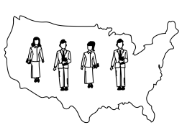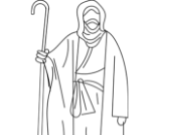Book of Mormon History Foreshadows Prophecies of Isaiah
When Mormon says, “I cannot write the hundredth part of the things of my people” (Words of Mormon 1:5), we might ask which criteria he used for including so little and excluding so much. Mormon and other prophets must surely have followed clear guidelines in so important a task.
3 Nephi 5:8
There had many things transpired which, in the eyes of some, would be great and marvelous; nevertheless, they cannot all be written in this book; yea, this book cannot contain even a hundredth part of what was done among so many people.
As the idea of “less than a hundredth part” appears six times in the Book of Mormon (Jacob 3:13; WoM 1:5; Helaman 3:14; 3 Nephi 5:8; 26:6; Ether 15:33), is that telling us something important to which we should pay attention, or should we simply dismiss it as irrelevant?
We discover a clue to the Book of Mormon’s guidelines for redacting its history in Isaiah’s “manner of prophesying.” Using key historical events of his day as types, Isaiah predicts new, end-time versions of them. The idea of sacred history repeating itself characterizes all prophecy.
Isaiah 44:7
Who predicts what happens as do I,
and is the equal of me
in appointing a people from of old as types,
foretelling things to come?
Isaiah draws on thirty ancient events to predict end-time ones. Apostasy, bondage, invasion, world war, utter destruction, exodus out of Babylon, Passover, wandering in the wilderness, reconquest of the land, building the temple, etc.—all repeat themselves before Jehovah’s coming.
When we compare Isaiah’s prediction of end-time events with Book of Mormon history, many parallels appear. Book of Mormon events described in most detail tend to match events that Isaiah predicts. Understanding Isaiah’s prophecy thus helps understand the Book of Mormon.
Isaiah’s predictions of an end-time exodus out of Babylon and wandering in the wilderness to new promised lands, for example, parallel many exoduses in the Book of Mormon. Jaredites, Lehi’s family, Mosiah’s people, Limhi’s people, Ammonites and others all took part in exoduses.
A Book of Mormon “exodus pattern” appears when we consider elements common to each exodus. Typically, a threatening situation causes God to warn a righteous remnant of his people to flee. Led by a man of God into the wilderness, they resettle in a new place where they prosper.
2 Nephi 5:5–6
The Lord did warn me, that I, Nephi, should depart from them and flee into the wilderness, and all those who would go with me. Wherefore, it came to pass that I, Nephi, did take my family, and also Zoram and his family, and Sam, mine elder brother and his family, and Jacob and Joseph, my younger brethren, and also my sisters, and all those who would go with me. And all those who would go with me were those who believed in the warnings and the revelations of God.
Omni 1:12–13
He [Mosiah] being warned of the Lord that he should flee out of the land of Nephi. . . . he did according as the Lord had commanded him. And they departed out of the land into the wilderness, as many as would hearken unto the voice of the Lord; and they were led by many preachings and prophesyings. And they were admonished continually by the word of God; and they were led by the power of his arm, through the wilderness until they came down into the land which is called the land of Zarahemla.
Mosiah 24:16–17, 19–20
The voice of the Lord came unto them again, saying: Be of good comfort, for on the morrow I will deliver you out of bondage. And he said unto Alma: Thou shalt go before this people, and I will go with thee and deliver this people out of bondage. . . . And in the morning the Lord caused a deep sleep to come upon the Lamanites, yea, and all their task–masters were in a profound sleep. And Alma and his people departed into the wilderness.
A similar phenomenon appears when we compare elements common to several major wars fought between the Nephites and Lamanites that are detailed in the book of Alma. These create a “war pattern” that is itself prophetic of an end-time war to end all wars that Isaiah predicts.
Alma’s, Moroni’s, and Moronihah’s wars against dissenters, kingmen, and Lamanites (Alma 2, 43–62; Helaman 1, 4) typify an end-time scenario in the Book of Isaiah in which many Gentiles fight against Zion and are cut off from God’s people (Isaiah 29:7–8; 48:19; 1 Nephi 22:14–20).
Covenanting to defend the cause of freedom and empowered by “the strength of the Lord,” the Nephite Christians and freemen vanquished their enemies. Wars that don’t follow the Book of Mormon’s war pattern—though more terrible or victorious—are depicted in the briefest terms.
Alma 28:2–3
There was a tremendous battle; yea, even such an one as never had been known among all the people in the land from the time Lehi left Jerusalem; yea, and tens of thousands of the Lamanites were slain and scattered abroad. Yea, and also there was a tremendous slaughter among the people of Nephi; nevertheless, the Lamanites were driven and scattered, and the people of Nephi returned again to their land.
Mormon 2:26–27
We did pursue them with our armies, and did meet them again, and did beat them; nevertheless the strength of the Lord was not with us; yea, we were left to ourselves, that the Spirit of the Lord did not abide in us; therefore we had become weak like unto our brethren. And my heart did sorrow because of this the great calamity of my people, because of their wickedness and their abominations. But behold, we did go forth against the Lamanites and the robbers of Gadianton, until we had again taken possession of the lands of our inheritance.
In Isaiah’s end-time scenario, God’s servant called Righteousness vanquishes those of his people who turn against God and leads God’s armies against invaders. After God tests his people to see where their loyalties lie, he endows his servant with power over all who fight against Zion.
Isaiah 41:2
Who has raised up Righteousness from the east,
calling him to [the place of] his foot?
Who has delivered nations to him,
toppled their rulers,
rendering them as dust to his sword,
as driven stubble to his bow?
Acts 1:9–11
When he [Jesus] had spoken these things, while they beheld, he was taken up; and a cloud received him out of their sight. And while they looked steadfastly toward heaven as he went up, behold, two men stood by them in white apparel; Which also said, Ye men of Galilee, why stand ye gazing up into heaven? This same Jesus, who is taken up from you into heaven, shall so come in like manner as ye have seen him go into heaven.
While many historical patterns in the Book of Mormon typify events that Isaiah predicts, Jesus’ coming to the Nephites after his resurrection stands out. Had not angels prophesied his return to his apostles at the time he ascended into heaven, after he had taught them for forty days?
Jesus’ coming to the Nephites follows this same pattern. The resurrected Christ descends out of heaven and ministers to his elect people. He teaches them out of the scriptures many days and establishes his church among them. He promises to return and establish his kingdom on earth.
3 Nephi 11:8
And it came to pass, as they understood they cast their eyes up again towards heaven; and behold, they saw a Man descending out of heaven; and he was clothed in a white robe; and he came down and stood in the midst of them.
3 Nephi 26:3
And he did expound all things, even from the beginning until the time that he should come in his glory—yea, even all things which should come upon the face of the earth, even until the elements should melt with fervent heat, and the earth should be wrapt together as a scroll, and the heavens and the earth should pass away.
Isaiah predicts Jesus’ second coming as Jehovah’s coming to reign on the earth. Just as a great and terrible destruction and divine deliverance preceded his coming to the Nephites, so “utter destruction” occurs before Jehovah/Jesus comes as his people’s Salvation (Isaiah 28:22; 62:11).
Isaiah 59:17–20
He clothed himself with vengeance for a garment
and wrapped himself in fury as in a robe.
According to what they deserve, he will repay them:
wrath upon his adversaries,
reprisals upon his enemies;
to the isles he will render retribution.
From the west men will fear Jehovah Omnipotent,
and from the rising of the sun his glory.
For he will come [upon them] like a hostile torrent
impelled by the Spirit of Jehovah.
But he will come as Redeemer to Zion,
to those of Jacob who repent of transgression.
Read More Key Book of Mormon Areas of Interest
Recommended Reading
& Listening
Avraham Gileadi, Studies in the Book of Mormon. Forty-eight insightful mini-studies in the Book of Mormon for LDS readers that open invaluable layers of meaning hitherto overlooked. Hebron Books, 2012: 192 pages. Softcover $15.95; E-Book $7.95; MP3 $7.95.











